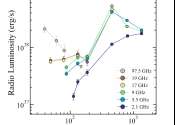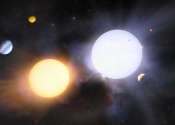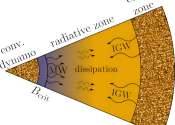Last update:
Astronomy & Space news
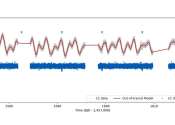
TOI-837 b is a young Saturn-sized exoplanet with a massive core, observations find
European astronomers have performed photometric and spectroscopic observations of a distant giant exoplanet known as TOI-837 b. As a result, they found that TOI-837 b is a young Saturn-sized planet containing a massive core, ...

Webb telescope probably didn't find life on an exoplanet—yet
Recent reports of NASA's James Webb Space Telescope finding signs of life on a distant planet understandably sparked excitement. A new study challenges this finding, but also outlines how the telescope might verify the presence ...
Astrobiology
16 hours ago
0
44

Intercropping viable for optimizing vegetable production on Mars
A group of crop systems analysts at Wageningen University and Research, in the Netherlands, has found evidence that intercropping on Mars could be a viable option for optimizing vegetable production.

X-ray satellite XMM-Newton sees 'space clover' in a new light
Astronomers have discovered enormous circular radio features of unknown origin around some galaxies. Now, new observations of one dubbed the Cloverleaf suggest it was created by clashing groups of galaxies.
Astronomy
16 hours ago
0
56

Two small NASA satellites will measure soil moisture, volcanic gases
Two NASA pathfinding missions were recently deployed into low-Earth orbit, where they are demonstrating novel technologies for observing atmospheric gases, measuring freshwater, and even detecting signs of potential volcanic ...
Planetary Sciences
13 hours ago
0
16

China set to blast off to the far side of the moon—here's what it could discover
China is attempting to recover the first ever soil and rock samples from the lunar far side. The surface mission, Chang'e 6, named after the Chinese moon goddess Chang'e, is a successor to the successful sample return mission, ...
Space Exploration
15 hours ago
0
17

Pulsed plasma rocket (PPR): Shielded, fast transits for humans to Mars
The future of a space-faring civilization will depend on the ability to move both cargo and humans efficiently and rapidly. Due to the extremely large distances that are involved in space travel, the spacecraft must reach ...
Space Exploration
13 hours ago
0
16

The Great Observatory for Long Wavelengths (GO-LoW) proposal
Humankind has never before seen the low frequency radio sky. It is hidden from ground-based telescopes by the Earth's ionosphere and challenging to access from space with traditional missions because the long wavelengths ...
Astronomy
13 hours ago
0
31

Japanese aerospace company captures an actual picture of space debris
Space debris is a growing problem, so companies are working on ways to mitigate it. A new satellite called ADRAS-J was built and launched to demonstrate how a spacecraft could rendezvous with a piece of space junk, paving ...
Space Exploration
13 hours ago
0
1

Fluidic telescope (FLUTE): Enabling the next generation of large space observatories
The future of space-based UV/optical/IR astronomy requires ever larger telescopes. The highest priority astrophysics targets, including Earth-like exoplanets, first generation stars, and early galaxies, are all extremely ...
Astronomy
13 hours ago
0
51
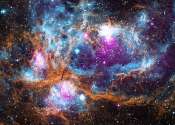
A 'cosmic glitch' in gravity: New model may explain strange behavior on a cosmic scale
A group of researchers at the University of Waterloo and the University of British Columbia have discovered a potential "cosmic glitch" in the universe's gravity, explaining its strange behavior on a cosmic scale.
Astronomy
May 1, 2024
7
320

New findings point to an Earth-like environment on ancient Mars
A research team using the ChemCam instrument onboard NASA's Curiosity rover discovered higher-than-usual amounts of manganese in lakebed rocks within Gale Crater on Mars, which indicates that the sediments were formed in ...
Astrobiology
May 1, 2024
0
1341

Horizontal running could help lunar astronauts retain physical conditioning
A small team of pathophysiologists and human locomotion specialists at the University of Milan has found that it should be possible for astronauts on the moon to prevent muscle and bone deterioration by running horizontally ...

Euclid telescope: Scientist reports on his quest to understand the nature of dark matter and dark energy
On July 1, 2023, Euclid, a unique European space telescope was launched from Cape Canaveral. The launch was undoubtedly the highlight of my career as an astronomer, but witnessing the result of years of work being put on ...
Astronomy
May 1, 2024
2
52

NASA/JAXA's XRISM mission captures unmatched data with just 36 pixels
At a time when phone cameras are capable of taking snapshots with millions of pixels, an instrument on the Japan-led XRISM (X-ray Imaging and Spectroscopy Mission) satellite captures revolutionary science with just 36 of ...
Astronomy
May 1, 2024
0
20

NASA does Dragon shuffle prepping for Starliner launch
Parking is at a premium at the International Space Station, but NASA and SpaceX cleared out one spot as a cargo Dragon spacecraft completed its trip home with a splashdown off the Florida coast.
Space Exploration
May 1, 2024
0
1

NASA balloons head north of Arctic Circle for long-duration flights
NASA is set to begin launch operations mid-May for the 2024 Sweden Long-Duration Scientific Balloon Campaign. Four stadium-sized, scientific balloons carrying science missions and technology demonstrations are scheduled to ...
Planetary Sciences
May 1, 2024
0
8

Astronomers significantly impact the climate by traveling to conferences, say researchers
In 2019, global travel to international academic conferences in the field of astronomy caused the equivalent of 42,500 tons of climate-damaging CO2 emissions. This equates to an average of one ton of CO2 per participant and ...
Astronomy
Apr 30, 2024
3
23

Citizen scientists help discover record-breaking exoplanet in binary star system
A team of astronomers and citizen scientists has discovered a planet in the habitable zone of an unusual star system, including two stars and potentially another exoplanet.
Astronomy
Apr 30, 2024
0
591

Researchers explore an old galactic open cluster
Using data from ESA's Gaia satellite, astronomers from Turkey and India have investigated NGC 188—an old open cluster in the Milky Way. Results of the study, published April 19 on the pre-print server arXiv, deliver important ...
More news

Enceladus spills its guts through strike–slip motion

Launch date set for NASA's PREFIRE mission to study polar energy loss

JWST uses interferometry mode to reveal two protoplanets around a young star

Two new satellites join the Galileo constellation

Chinese astronauts return to Earth after 6 months on space station

Probing the effects of interplanetary space on asteroid Ryugu

New study reveals mystery of decaying exoplanet orbits

NASA scientists gear up for solar storms at Mars
Other news

New eco-friendly lubricant additives protect turbine equipment, waterways

Twisting and binding matter waves with photons in a cavity

New sugar-based catalyst could offer a potential solution for using captured carbon


















































